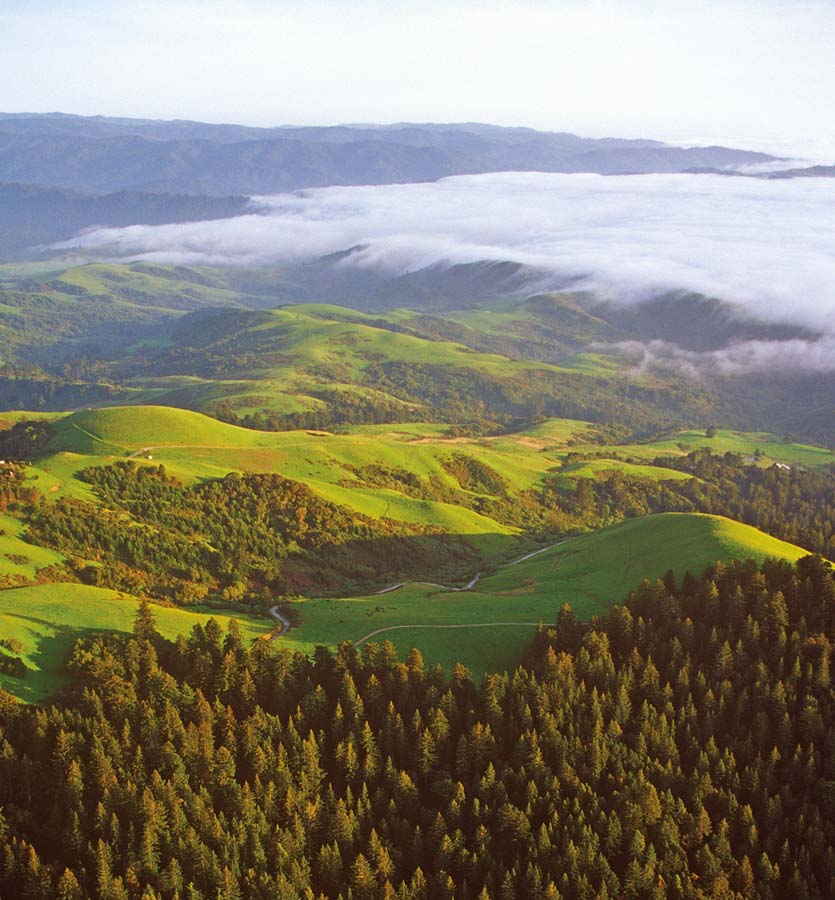The Grove of Old Trees sits on a hill in Sonoma County in full view of the ocean. “This is where I come to chase the fog,” says Emily Burns. But on this day in March, her prey is elusive. Buttercups gleam in the sunshine beside a fortress of redwoods scraping an azure sky.
Burns has been studying this 28-acre remnant old-growth forest for almost a decade—especially the plants’ relationship with the area’s bounteous, bone-chilling fog. She points out a vigorous sword fern—the subject of her current research—and introduces me to some redwoods over 200 feet tall.
A young biologist, Burns is a pioneer in the field of fog. She has risen before dawn, climbed to the tops of these trees, and measured the effects of fog on their uppermost shoots. In 2009 she published a landmark paper describing how plants in the Grove of Old Trees use fog—part of a growing body of evidence demonstrating fog’s central role in sustaining California’s coastal ecosystems.
These days, Burns is on a broader quest. As head of conservation planning at the San Francisco–based nonprofit Save the Redwoods League, she’s trying to figure out what the climate-changed future may hold for redwood forests. And fog is a major wild card: Some theories suggest more fog is likely, others less. So Burns and a small group of other biologists are crossing the traditional borders of their field—working with physicists, hydrologists, and meteorologists—to demystify the mists. The job involves everything from measuring fern fronds to teasing out the atomic composition of redwood leaves in a lab. Some of the most important work is centered right here, among the ancient redwoods of the California coast.
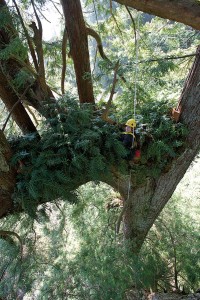
The Bay Area’s climate is like few others in the world, especially in summer: We can be shivering at 50 degrees along the coast and Bay shore, but then drive a few miles inland and be sweating at over 100. If we don’t like the cold and damp, we can go east—or up. Or stay where we are and wait until noon.
Fog provides us with natural air-conditioning, lower energy bills, and more diverse vegetation and wildlife than we should expect in a place that receives an average of only 20-some inches of rain a year. In summer, coast redwoods can get more than half of their moisture from fog. Scientists once assumed the trees had to soak up fog’s drippings from the soil. But then, in 1998, UC Berkeley biologist Todd Dawson showed that they could also absorb moisture through their leaves. Burns, a student of Dawson’s, built on that knowledge, showing that eight other plants in the forest, including sword ferns, huckleberries, and tanoaks, were capable of “foliar uptake” too.
Fog can be surprisingly wet. Three years ago, physicist Daniel Fernandez of California State University, Monterey Bay, began measuring its water content. His record haul from a one-square-meter fog collector: 39 liters, or nearly 10 gallons, in a single day.
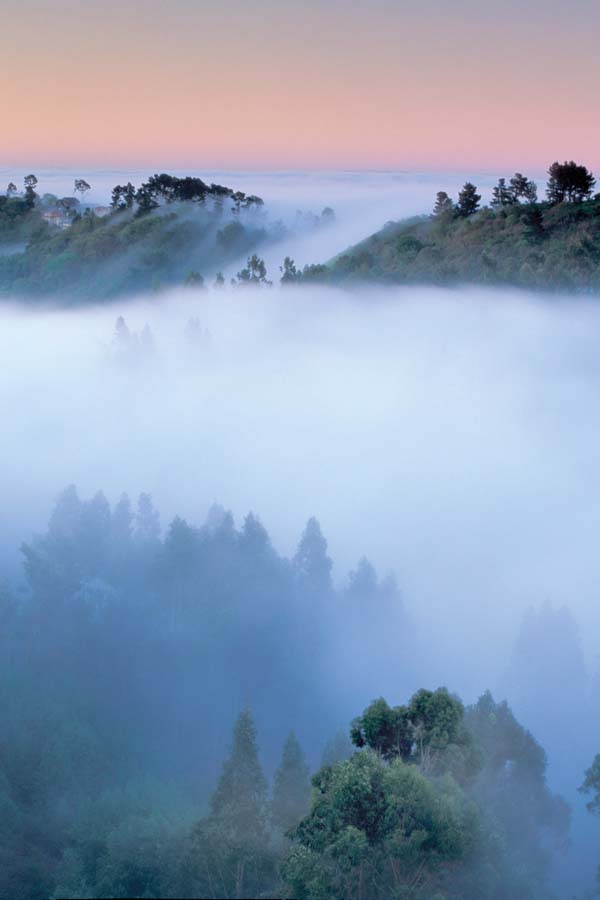
Coastal fog is formed by a complex interaction of land, ocean, and atmosphere. But the basics are as simple as a glass of iced tea. Just as moisture in the air condenses when it comes in contact with the cold glass, fog forms when a warm air mass comes in contact with cold ocean water. On a hot day in the Central Valley, the fog moves inland, pushed by the prevailing winds and pulled by the rising warm air in the valley.
It’s an elegantly timed hydration system. In a daily, or “diurnal,” cycle fog often provides moisture at night and burns off during the day, when plants need sun for photosynthesis. Over the course of a year, fog is (conveniently) most abundant during our nearly rainless summers.
How much fog we have in any given year is determined by factors still poorly understood. The difference between inland temperatures and temperatures along the coast plays a part. But there are other factors, too, including atmospheric shifts of the jet stream and air pressure out at sea, as well as an ocean cycle called the Pacific Decadal Oscillation, in which water temperatures in the eastern and western Pacific seesaw between colder and warmer every 20 or 30 years. Add human-caused climate change, and even bold scientists grow cautious. “I don’t predict the future, only the past,” jokes researcher Jim Johnstone of the Joint Institute for the Study of the Atmosphere and Ocean at the University of Washington. “That’s fairly safe.”
In 2010 Johnstone coauthored a paper on this topic published by the National Academy of Sciences. Basing his findings on historic temperature data and measurements of fog ceiling heights from airports along the California coast, he concluded that fog had decreased by 33 percent over the past 100 years. “Coast redwood may be increasingly drought-stressed under a summer climate of reduced fog frequency and greater evaporative demand,” the paper concluded.

Redwoods in trouble? That got land managers and conservationists’ attention. But it wasn’t the whole story. The previous year, a team led by San Jose State meteorology professor Robert Bornstein published a paper in the Journal of Climate. Basing his findings on records of air temperatures in Los Angeles and San Francisco, Bornstein argued that “summer daytime temperatures on the coast have been cooling since 1970,” which suggests more fog rather than less. The likely reason? Global warming is adding energy to the diurnal cycle. Hotter inland temperatures are drawing in more fog to coastal areas.
Before his paper was published, Johnstone pored over Bornstein’s numbers and found that “the calculations were perfectly good.” Johnstone decided that their differing conclusions stemmed from sampling in different places and looking at different time periods. “It matters a lot when you start looking for a trend,” Johnstone says.
Recent weather data seems to bolster Bornstein’s case. Even Johnstone admits that “the coastal ocean has cooled and fog frequency has been considerably above normal, particularly in the past three summers.” But he points to evidence suggesting that those changes are more likely due to “natural variation,” age-old cycles in and over the Pacific, than to recent warming in inland areas. “Fog does not fit neatly into a greenhouse warming story,” he says.

So how much have fog levels varied in the past? In 1998, UC Berkeley’s Dawson used analysis of isotopes—atoms of a particular element, such as carbon, with differing numbers of neutrons—to show that redwoods were absorbing fog directly through their leaves. His latest work uses isotope analysis to dig deeper, taking advantage of redwoods’ long lives. “Redwoods live 2,000 years or more,” says Dawson. “We can analyze their tree rings to go way, way back in time.”
This is not your father’s tree-ring analysis, however, which simply showed how much a tree had grown each year. “Locked into the tree’s cellulose molecules are carbon and oxygen atoms,” Dawson says. By examining the mix of carbon and oxygen isotopes in the cellulose of a given tree ring, Dawson can distinguish rain from fog and a hot year from a cool one.
“If rain falls, the oxygen isotopes that are incorporated into the tree rings are different from the oxygen isotopes from fog water,” Dawson says. “So I can tell you whether the tree built that ring using water dominated by summer fog or winter rainfall. Taking that information and combining it with the isotope information we get from carbon, I can tell you whether it was a warm year or a cool year—and how trees responded to that combination of water and temperature.”
“We’re trying to look back before the Industrial Revolution, when we started putting CO2 into our atmosphere and changing the temperature,” Dawson says. “Are there natural cycles between foggy and less foggy years? Or have some of those changes in fog been linked to recent, human-induced climate events? The tree rings will tell us.”
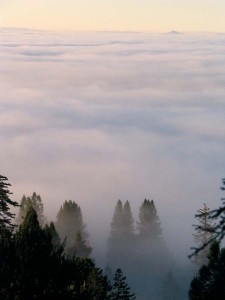
Another way to understand what’s happening to forests and fog is to start measuring here and now. Working with Dawson and other scientists at UC Berkeley and Humboldt State University, Save the Redwoods League began collecting comprehensive data on forest health in 2009. Through its Redwoods and Climate Change Initiative, the league has established study plots in 11 redwood forests along the coast and five giant sequoia forests in the Sierra Nevada. They’re mapping every plant in these one-hectare plots, and noting the size, age, and growth of the largest redwoods and sequoias. They’ll re-measure and re-map each year, for as long as they can keep the effort going.
So far, they’ve found no drought-induced mortality or declines in growth within the 450 mile-long native range of coast redwoods. The league has also confirmed these forests’ vital role in climate stabilization. With their expansive foliage and great girth, these old growth trees are actually growing faster—that is, adding more biomass—than younger ones, and hence storing more carbon. According to Burns, “These trees are pulling a lot of carbon out of the atmosphere. I think the data is going to show that North Coast redwood forests [which contain the largest trees] are holding more carbon than any other forests on the planet.”
The initiative will eventually help shape the league’s response to global warming. “These are the best old-growth forests we have,” Burns says. “We want to understand if there are climate change impacts. And if we see an area that’s a refuge from climate change, we are going to ramp up efforts to protect it.” The search for refugia does not mean turning away from efforts to preserve drier, more southerly forests, such as those along the Big Sur coast, however. “We don’t know the magnitude or even the direction of the climate changes we’re facing,” Burns says. “So we’re not planning on abandoning any forest land. That would be a big mistake.”
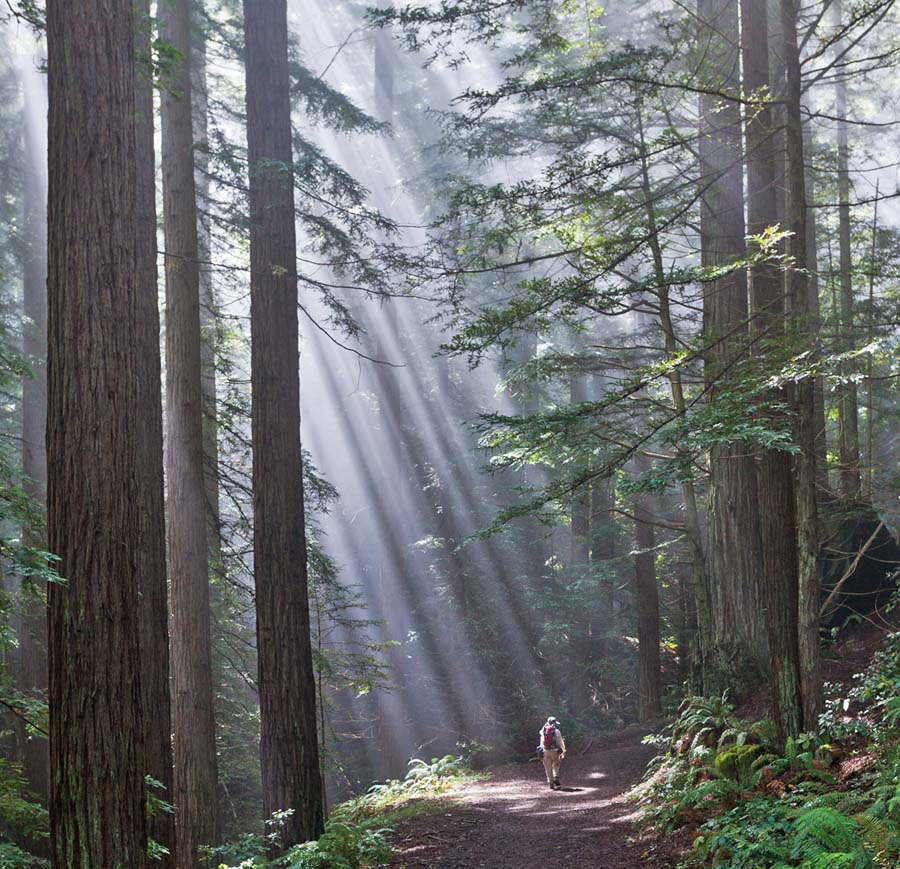
Beyond the redwoods, fog is a powerful influence on other landscapes along the California coast. When U.S. Geological Survey landscape ecologist Alicia Torregrosa heard about a possible decline in fog, she first thought about salmon. Flows in the salmon creeks she was studying just north of San Francisco are sometimes very low in the summer. With less fog, those creeks might heat up more quickly, creating, she says, “a double whammy” for fish.
Colleagues suggested other concerns. What about maritime chaparral, with its diverse array of fog-dependent plants found nowhere else on the planet? What about fog-fed dune plants and the amphibians adapted to life along the coast? What about the wine industry? What about human health and energy consumption? There were countless reasons to try to understand what was happening to fog.
At first Torregrosa tried to figure it out on her own. “Using existing satellite data I thought I could get nice views over time,” she says. Soon, however, she was climbing “a mountain of atmospheric science research” designed to predict the weather and avoid plane crashes. “There was a lot of coarse data, but nothing biologically relevant,” she says.
So Torregrosa decided to build a fog brain trust. In April 2012, she hosted 36 atmospheric and natural scientists at the inaugural meeting of the Pacific Coastal Fog Team. The event gave scientists studying ocean currents and atmospheric pressure a chance to talk with scientists studying salamanders and manzanitas. There were revelations on both sides. “The wealth of information we found among atmospheric scientists was mind-boggling,” Torregrosa says. “And a lot of them didn’t realize there was such an ecological need for their information.”
Since that first meeting, the Fog Team has been knitting together observations from the middle of the Pacific Ocean to the tops of the tallest redwoods. Before the end of the year, they hope to produce data for resource managers facing decisions about what lands to buy, what lands to restore, and how to minimize damage in an era of climate change. “A better understanding of fog patterns will give them a better understanding of where fog-reliant plants can live,” she says.
Dawson of UC Berkeley is among the team’s biologists. “If we really want to see how the coastal climate is changing and how coastal fog is changing, we need to be making lots of measurements in lots of places,” he says. “No single person can do that. We need a consortium of people with like interests.”
Fortunately, the mighty redwoods don’t appear to be fazed by climate change yet. Looking up at a tree as tall as a 20-story building, Save the Redwoods League’s Burns points to its silvery tips. “Those are the healthy redwood shoots pushing upwards,” she says. “That’s only possible if there’s enough water.”
Such observations are reassuring. But we’re still at the beginning of the story about climate change and fog. We know fog so far has buffered the California coast from the big heat waves and droughts suffered by inland areas. But as to its future in a climate-changed world, “fog is so dynamic and ephemeral,” Burns says. “We don’t yet have the data to get a handle on the whole phenomenon.”
“Dispatches from the Home Front” is a series of articles highlighting groundbreaking work being done by Bay Area institutions, agencies, and nonprofit groups to comprehend, mitigate, and adapt to the impact of climate change on Bay Area ecosystems. The series is a partnership with the Bay Area Ecosystem Climate Change Consortium (baeccc.org). More at baynature.org/climate-change.
Funding for “Dispatches From the Home Front” has been provided by the State Coastal Conservancy, The Nature Conservancy, and Pacific Gas & Electric Company.

